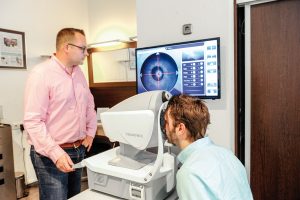Starting in summer 2018, a new project will examine 2,000 subjects and take their DNA samples, to understand how prevalent eye disease is in Malta and the reasons why. Here, MR FRANCIS CARBONARO explains why this is so important. This is another RIDT funded project.

Mr Francis Carbonaro
The question in the title is currently unanswerable – not because we don’t have the means to know but because the data has never been collected, which brings us to another pertinent question: How can the authorities create a plan for the nation’s eye-care when we don’t have the basic data?
Enter Mr Francis Carbonaro, a consultant ophthalmologist at Mater Dei Hospital and visiting senior lecturer at the University of Malta, who is currently preparing a plan for a nation-wide research project that will see 2,000 people aged 40 to 80 undergoing tests, answering questionnaires and donating DNA samples. The results – which will be comprised of the details of one per cent of the population within that age bracket – will, finally, give researchers and authorities a definitive look at the prevalence of eye disease in Malta.
“The Maltese are a very homogenous people, who historically have tended to marry other Maltese people,” Mr Carbonaro explains. “For this reason, our genetics may be specific to us and different from rest of Europe. Moreover, that is only one factor that could be affecting the nation’s eye health, with the environment and people’s lifestyles also playing an important role.
“By understanding the links between Maltese people’s genetics, lifestyles and the environment they live in, and the prevalence of eye diseases (such as glaucoma, cataracts, and diabetic retinopathy), we will finally have an idea of the scale of the situation and what can be done to make Maltese people’s eye-health better.”
In order for the tests to be carried out in a systematic manner that is both random but all-encompassing, the islands will be divided into several different regions, with people being called in to take part using the information available through the census or the ID-card register. Not all people who take the test need to have been diagnosed with eye disease, either, as the sample will be randomly selected and aims to see how prevalent eye disease is.
Each test, as Mr Carbonaro explains, will take around an hour and will involve three parts: a series of tests to determine visual acuity, eye pressure and the status of the optic nerves; the taking of a DNA sample (most likely through saliva); and a questionnaire that looks at people’s lifestyles, including diet, medical history, age and location.
Working on the project alongside Mr Carbonaro will be a PhD student, and the project has already received over €132,000 in funding from the Malta Community Chest Fund secured through RIDT. The money will mostly go towards the equipment needed to carry out the research, including a state-of-the-art VX120 multi-diagnostic machine that will make tests easier and faster to carry out.

“The research will take around two to three years to complete, but it’s only the beginning,” continues Mr Carbonaro. “The DNA samples collected throughout the research, in fact, will be part of our second study, which will look at the genetic links. Then, both the original results and the results from the second study can be juxtaposed to those of other countries in Europe to give us a better idea of where we stand, and even be included in wider, multinational research projects, giving local researchers a chance to further their work, and give local patients the chance to be part of international clinical tests, among others.”
The idea for all this came to Mr Carbonaro while he was reading for a PhD in Genetic Epidemiology of Glaucoma in the UK, and the project is a multi-faceted one that – with the right amount of support and funding – could take researchers into unchartered waters for the next 10 years. Indeed, among his many plans for this research, Mr Carbonaro hopes to be able to get as many of the subjects analysed now to retake the test in five to 10 years’ time to see how their eye-health has fared over the years; and also to create Malta’s first Blind and Sight-impaired Registry.
“Having a Blind and Sight-impaired Registry is an essential part of ensuring that people in such situations are getting the help they need. In the UK, for example, this register helps blind and sight-impaired people get access to better care, certain tax benefits (such as being exempt from paying the TV licence), etc. So, it’s not simply a list, but a way of knowing who needs our help.”
Kicking off in just six months’ time, the project will most definitely be coming to a district near you. So, if you do get a phone call asking you to join, we really recommend you do. Your contribution, after all, could help hundreds of people in the future!
Help us fund more projects like this, as well as research in all the faculties, by donating to RIDT. Click here for more information on how to donate.
